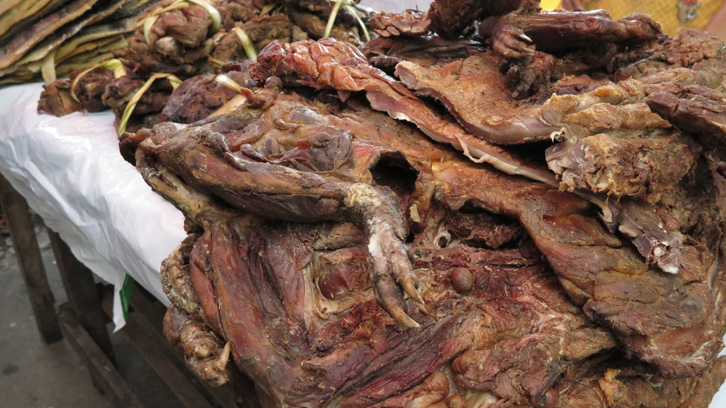Wild meat trade in tropical urban markets

Wild meat represents an important source of protein and income for local people in tropical forests worldwide. However, the trade of wild meat trade to supply urban markets is considered a main cause of population declines of many game species. Although the sale of wild meat by local hunters can be an important source of revenue for poor families, a greater emphasis on profits will cause a rise in wildlife harvest rates. On the other hand, volume of wild meat sold in urban markets may indicate the level of sustainability of hunting in rural areas.
Therefore, developing statistically robust techniques to understand the wild meat trade in urban markets is essential to enable appropriate management strategies to emerge for the control of demand and supply of wild species used for food. In the Amazon, where the commercial route of goods depends on the distribution of rivers, the supplying of wild meat usually concenters in the largest urban markets along large rivers; surveying these markets may be a low-cost method to assess impacts of hunting of wildlife populations. Nevertheless, wild meat markets are illegal complex systems that often vary over time and vendors distrust researchers.
In this study, during two years (2006-07 and 2017-18) we conducted a total of 4,524 vendor interviews in the Belén Market in Iquitos (Peru), the most important and largest open market in wildlife in the Amazon, to model the minimum effort required to obtain reliable information on the amount of wild meat trade.
Although the trade in wild products in urban markets is forbidden in Peru (Law No 29763), the surveillance authorities have been unable to enforce this law due to logistical and financial limitations and the high traditional demand for wild meat. In 2006-07, 220 tons of wild meat were annually sold (663 kg per day), in 2017–2018 this amount reached 288 tons (886 kg per day). In scenarios where the daily amount of wild meat on sale was between 40 and 650 kg, a minimum sampling effort of two interview-days per month provided good accuracy. However, in scenarios where wild meat traded was less frequent, as in the case of primates or rarer species, an effort of at least one interview per week is required. Vendor declaration of the daily amounts of meat sold was similar to the quantity on sale suggesting that sellers are aware of the volume of wild meat brought to market. To accurately monitor the trade of wild meat in urban markets we recommend a minimum sampling effort ranging from one interview per week to two interviews per month, depending on the amount of wild meat traded; in other occasions, a punctual interview on meat sellers’ perception may also be useful. The long-term monitoring of Amazonian urban markets, and tropical forests worldwide, can stand as a cost-effective and accurate indicator of the regional conservation status of wildlife and may be essential to anticipate management strategies that provide a response to population crisis of wildlife species, especially game species.
Universitat Autònoma de Barcelona
References
Mayor P, El Bizri HR, Morcatty TQ, Moya K, Solis S and Bodmer RE. (2019). Assessing the Minimum Sampling Effort Required to Reliably Monitor Wild Meat Trade in Urban Markets. Frontiers in Ecology and Evolution, 7:180. DOI: 10.3389/fevo.2019.00180.


